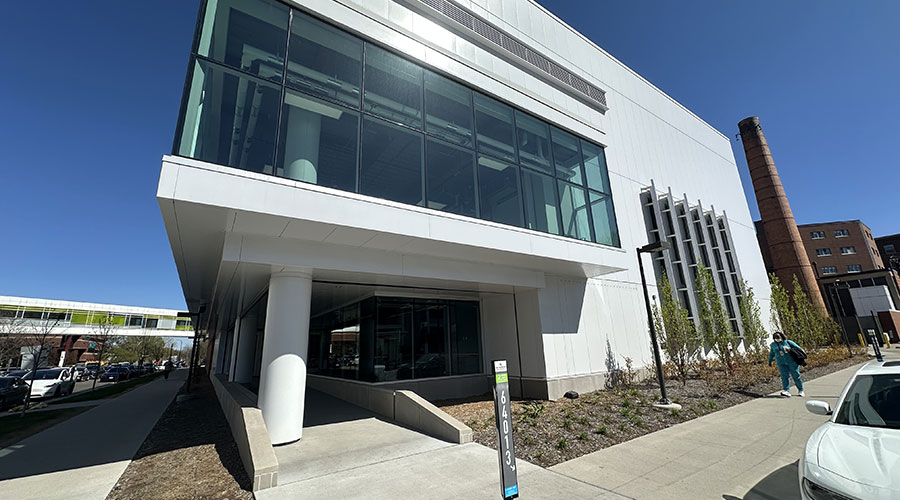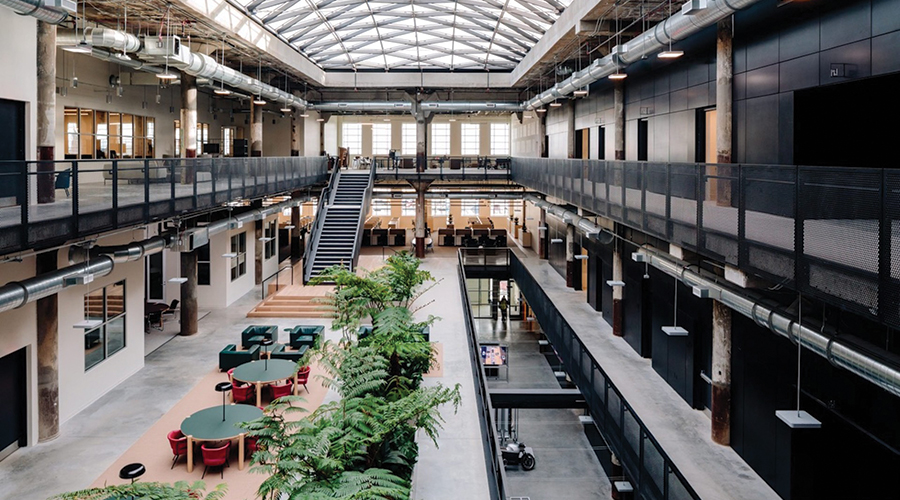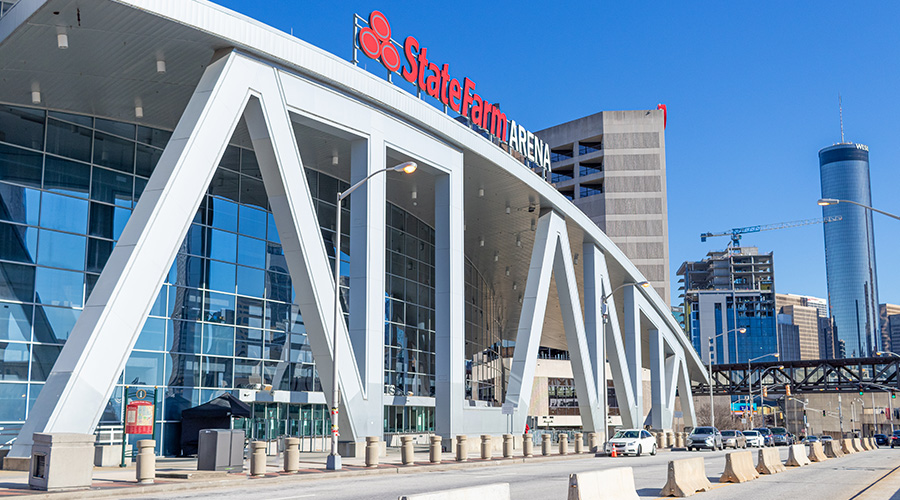Michigan Central Station Merges Energy Efficiency and History
The adaptive reuse of the Michigan Central Station offers lessons in bringing energy-efficient operations to historic facilities.
By Dan Hounsell, Senior Editor
The nature of historic facilities presents more than enough challenges for engineering and maintenance managers, architects and engineers responsible for breathing new life into them. But when the facility in question sat vacant for three decades and suffered from all of the neglect, decay and vandalism that time and weather can dish out, the challenges become overwhelming.
Such is the case with the Michigan Central Station, which opened in Detroit in 1913 as a passenger rail terminal, closed in 1988 as rail travel declined and reopened in June 2024. The process of renovating and restoring the station as a technology, commercial and community hub offers insights into the critical roles that operations, engineering and design play in renovating historic facilities to meet current demands for energy efficiency.
“If we can get the right owner and the right construction and the right architects and the right engineers in front of these projects, we can do some pretty spectacular things,” says Adam Whitt, principal with Buro Happold, the consulting engineer that worked with Ford Land on the station’s six-year renovation. “For adaptive reuse projects, that's going to be really key because all of these cities — Detroit, Chicago, Milwaukee — have buildings that are dilapidated and looking for new life to get breathed into them.”
Building challenges
Ford Motor Co. acquired the abandoned train station — an 18-story, 640,000-square-foot building — in 2018 to be the centerpiece of Michigan Central, a 30-acre technology and cultural hub.
“We were starting from scratch,” Whitt says of the building’s condition when renovation planning began. “Nothing there was able to be salvaged. It had either been decommissioned or got legs and walked out of the building. From an engineering perspective, that was good because you're not working with the constraints of an existing system.”
Before assessments of the facility could begin, though, the building’s condition created roadblocks.
“When we started the project, the basement was under water,” Whitt says. “That had to get pumped out.”
Specifically, 3.5 million gallons of water had to be pumped out of the basement, and 3,990 cubic yards of debris were hauled out of the building.
The station’s overhaul also included installing 4,200 light fixtures, 5.6 miles of plumbing, and 300 miles of wire and cable, and 102,000 square feet of windows were replaced or restored.
As with all adaptive reuse projects, one key challenge was ensuring the new services infrastructure could be retrofitted into the historic fabric — for example, locating air handling units and dedicated outdoor air system (DOAS) units in the station’s basement.
“The column spacing in the basement is very, very tight,” Whitt says. “It's kind of a large open space. We were tucked into corners in the basement, and we had situations where we had to do extremely tight coordination with our mechanical contractors and with the air handling unit vendors on how we get these units to fit in the space.
“It's to the point where we're sandwiched between two columns, and we have to coordinate access door locations and put in blank sections so we can get into these units. That presented challenges for the design, for how we work through that with the manufacturer."
The construction of the station’s basement presented problems in another important way. The basement was built in two levels. One level houses the boilers and the chillers and offers good access to get to loading docks, Whitt says. On the second, lower level sits the air handling units, and creating effective access to that level has been an issue.
“There are stairs, obviously, but there's no elevator,” Whitt says. “There's no lift. During construction, it wasn't a big issue because they had a temporary ramp built, and they could roll stuff down.
“Now that temporary ramp is out, and they’re looking at putting in a lift. We also had talked about parking a scissor lift down there and leaving it there.”
Whitt and his team also were challenged in their efforts to integrate the air distribution system into the fabric of the building.
“It's not a new building, so there's limited access to plenums, and there's a lot of historic spaces with vaulted ceilings,” he says. “We were really constrained to the core of the building, the shell of the building and making sure that what we did not only met the goals of the operation of the facility and was somewhat flexible in terms of the operation of the facility."
Through all of the physical challenges the structure presented, the team working on adapting it for reuse as a modern commercial, retail and technology kept in mind the character that a historic facility offers.
“Everything Ford could save, we did, and other elements were re-created through technology and tenacity,” says Melissa Dittmer, Michigan Central’s head of place. “At the same time, it was important to us to respect the station’s extraordinary past, including its ongoing role in Detroit’s cultural landscape. Weaving these histories through repurposed, state-of-the-art spaces will enable us to create an inclusive, forward-looking building that can propel innovation for the next 100 years.”
Eyes on energy
One crucial component of the adaptive reuse of the Michigan Central Station that began in 2018 is the goal of implementing energy-efficient technology and operations.
“We were really trying to push the envelope on what we could do from an energy performance perspective,” Whitt says, adding that Ford set an energy use intensity (EUI) target of 60 for the reopened facility. "That was the target we were shooting for. We were trying to do things on top of that, but there are budget and other constraints that came along with that.”
Though the system has only been operating for a few months, the results have been promising.
"Our (EUI) projection based on the improvements that we did was right around 41, so that quite a bit quite a bit better than the target,” Whitt says.
The historic nature of the station meant Whitt and his team needed to be creative in their system designs. Historically, the building had never included an air conditioning system, so they needed to find space between floors to accommodate this. The team used computational fluid dynamics (CFD) and the latest digital energy modelling software to ensure the cooling and heating strategies were effective throughout the building.
As an example, Whitt points to the station’s podium level that featured large, vaulted spaces.
“We did a lot of CFD analysis on how we distribute air into the space because we have limited opportunities to put diffusers,” he says. “It's not like we can just run a duct down the middle of these spaces and distribute air.”
The solution was to discharge air relatively low in the space.
“We have air that gets distributed into these large, vaulted spaces low and slow within the space," he says. “We didn't want to have super-cold air, but we still wanted to dehumidify the air. So the air handling units that serve the concourse level have passive desiccant wheels to dry the air out before we discharge it in the space. It allows us to dehumidify and warm up the air at the same time for lower energy costs.”
Heating equipment featured in the upgrade included four 5,000 MBH natural gas high-efficiency boilers.
“It's a hydronic heating water distribution system,” Whitt says. “Those boilers are responsible for not only the heating of the building but also for the domestic water heating demands of the building.
The cooling side of the project featured two 750-ton and one 500-ton water-cooled centrifugal chillers and four cell counterflow cooling towers on site, which created their own location challenges.
"We have cooling towers out on site that kept getting further and further away from the building to the point where at one time, I thought they were going to end up in Canada,” Whitt says. “They didn’t want to see them. Because it's historic, we didn’t have an opportunity to just to pop them on the top of the building.”
Station operations
Whitt says he and his team worked closely with the station’s in-house operations staff at Ford Land and their engineers discussing the proposed HVAC systems and the in-house team’s expectations.
“This building is quite a bit different than anything that they have in their portfolio,” he says. “They're obviously working primarily for a motor company. They do have some offices, but a lot of what they're doing is more geared toward manufacturing. The redundancy, the resiliency, the expected operations system is quite a bit different for a commercial office building than it is for a manufacturing facility.”
While the renovated station opened to the public in June, Whitt says the process of fully understanding and fine-tuning the installed equipment and technology continues.
“The system is still getting commissioned," he says “Within the last month or so as things have started to settle down, we've started to see some of the creaks in the system, and we’ve been working through that with the construction team and the operations team.”
The many challenges created by the historic nature of the Michigan Central Station and the cutting-edge technology designed to ensure the station’s long-term energy efficiency have combined to present a unique set of challenges for the design, engineering and operations teams responsible for its performance.
“There's a misconception,” Whitt says. “You can't just flip a switch and turn it on and walk away. These are complex systems with a lot of physics and thermodynamics that go into the operation of them and that change with the seasons, and the dynamics within the spaces have an impact on how this system operates.”
Nonetheless, Whitt says the station offers hope for future opportunities to bring present-day operations to historic facilities.
“We always just assume that these older buildings are going to be not very energy efficient,” Whitt says. “But when we start looking at the construction of the building and the window-to-wall ratios, we can get these buildings from an adaptive reuse perspective to operate very energy efficiently with the right teams in place.”
Dan Hounsell is senior editor for the facilities market. He has more than 30 years of experience writing about facilities maintenance, engineering and management.
Related Topics:












